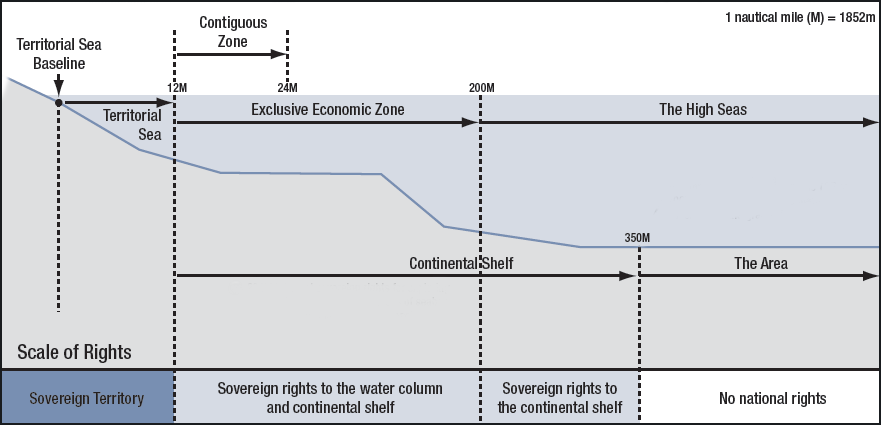International Law of the Sea, download in below
International Law of the Sea
- 1. CHAPTER 2INTERNATIONAL LAW OF THE SEA
- 2. Father of International Law responsible for the concept of ―freedom of the seas Hugo Grotius
- 3. ―No part of the sea maybe regarded as pertaining to the domain of any given nation.‖
- 4. Western civilization became increasingly dependent upon the use of the sea for:• Trade• Transportation• Communication
- 5. A 3-mile territorial sea zone was claimed in the seventeenth century.
- 6. A 12-mile fishing zone claimed by Imperial Russia in the early 1900s.
- 7. After the Law of the Sea Conference in1978, most maritime nations adopted a12-mile territorial sea zone.
- 8. The United States predicated final acceptance of this 12 mile limit only if the law allowed for unimpeded passage through, over, and under international straits overlapped by the12 mile limit.
- 9. TERRITORIAL SEA BASELINE CONTINENTAL SHELF Common Heritage THE Sovereign rights for exploring and exploiting non-living of man- AREA Resources of sea-bed and subsoil, plus sedentary species kind EXCLUSIVE ECONOMIC & SELF DEFENSE ZONE Sovereign rights for exploring, exploiting, HIGH SEAS and managing living and non-living Resources of the water, sea-bed, and subsoil. 200 Contiguous NM Zone 24 Territorial NM Sea 12 Sea Level NM SHELF UPPER PLATEAU SLOPE OR TERRACE LOWER DEEP SLOPE RISE OCEAN
- 10. The basic principles of the international law of the sea that have evolved over the centuries are:• High seas• Territorial sea• Special contiguous zones
- 11. High Seas The concept of freedom of the high seas contends that no nation may restrict any areas or resources to its exclusive use or sovereignty.
- 12. High Seas All parts of the sea that are not included in the territorial sea or in the internal waters of a state
- 13. Territorial Sheathe concept of the territorial sea contends that coastal states have near-absolute sovereignty over narrow band of waters adjacent toothier coasts.
- 14. Special Contiguous Zones The concept of special contiguous zones contends that special limited jurisdiction prevails, such as in the straits and channels, and where neither the rules of the high season territorial seas pertain.
- 15. UN Law of the Sea Conferences have met a number of times since 1973.
- 16. United Nations General Assembly
- 17. The stated purpose of the Law of the Sea Conferences has been ―to develop rules for peaceful use of the seabed beyond the continental shelf to the entire spectrum of ocean uses.‖
- 18. The UN recognized wide disagreement between developed nations and underdeveloped nations.
- 19. Underdeveloped States Industrialized States
- 20. The basic issues at the conference were:• The breadth of the territorial sea• Passage through straits• Fisheries• The seabed• Marine pollution• Scientific research
- 21. Ocean Surface Continental Shelf Continental Slope Abyssal Plain Sediment Base Continental Rise Ocean Floor
- 22. Over the years some conventions have been agreed upon, but no global agreement covering the many item son the agenda has yet been reached.
- 23. Four possible adverse impacts of international legal rules on the Navy’s missioninclude:1. Limited mobility2. Vulnerability to surveillance3. Vulnerability to interdiction4. Limitations on oceanographic and intelligence-gathering activities
- 24. Limited Mobility—Restrictions on passage increase reaction time to troubled areas.
- 25. Vulnerability to Surveillance—Requiring warships to use designated sea lanes increases surveillance.
- 26. Vulnerability to Interdiction—If the narrow sea-lanes were in a strait, mining of that area or attack by enemy naval and air forces would be much simpler than if a broad sea area were involved.
- 27. Legal developments might impose limitations on oceanographic and intelligence activities within the200-mile zones.
- 28. The maximum size of the territorial sea is 12 nautical miles.
- 29. Innocent Passage The right of vessels of one nation to navigate peacefully through the territorial waters of another nation
- 30. Oil Tanker Passage through a territorial sea must be continuous and expeditious.
- 31. Stopping and anchoring is allowed only to provide assistance to persons, ships, or aircraft in danger or distress.
- 32. A littoral (coastal) state must not hinder innocent passage.

